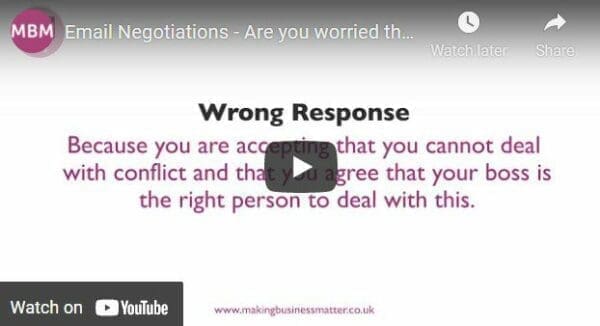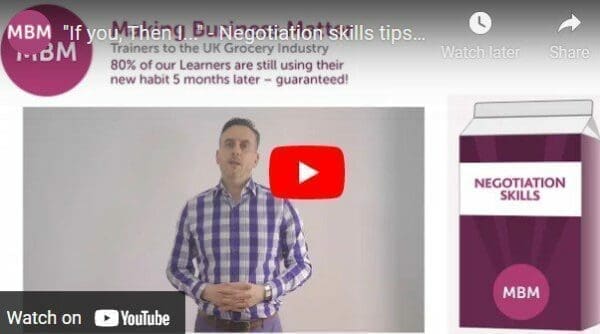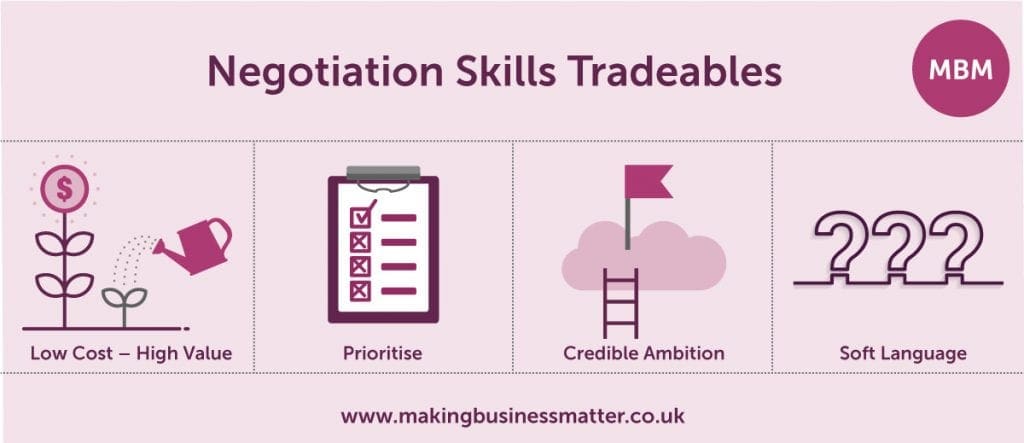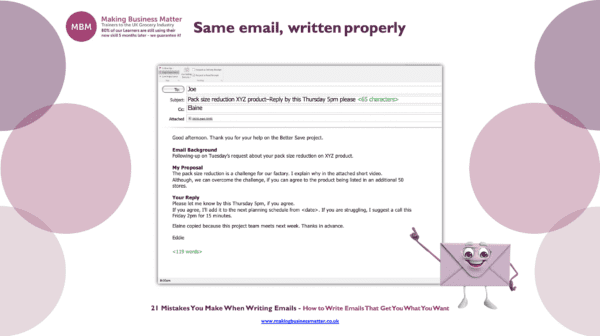The Challenges of Conducting Negotiations by Email
Negotiation by email and negotiating by phone, or through WhatsApp, text, or any other written form is hard. Hard because you are blind. This article can help you to write and speak your negotiations much better.
Sections in this article are below:
- The Art of Negotiation
- 7 Principles of Negotiation Still Apply
- 19 Tips for Conducting Negotiations by Email, and Through Other Written Word Forms
- Still Struggling and Looking for That Magic Bullet?
The Art of Negotiation
Negotiation is an art, not a science. An art because it involves human beings! With their many complex thoughts, emotions and attitudes. All of which can and do affect the final outcome. When negotiating via the written word, or by phone, we lose a lot of behavioural feedback. The messages you would have got from a face to face meeting. We use these cues subconsciously to help us understand what is truly happening in the negotiation.
Albert Maerabin’s research into words, tone and body language was pioneering, but we know that you just want to get to the good stuff – The ‘How can I be better at negotiation by email?’, so we’ll just leave you with this video, which we like. In essence, it says that the other cues are important, just don’t get too hung up on the numbers of what percentage of feedback we lose by not seeing the body language or hearing the tone.
Email negotiation is like being put into a boxing ring blindfolded!
So, to some extent we guess, maybe estimate, assume, and certainly hope for the best. That said, we can help you to ‘box more cleverly’ with this article on email negotiation. Helping you to be the best version of yourself when negotiating on email, phone, or any other written forms.

Are You Worried You’re Not Getting the Best Deal When Negotiating by Email?
Watch the video below and read on to learn some useful tips to win more often:

Sticky Learning ® is 7 times more effective than 1-day training courses. Plus, you will get a Chain of Evidence proving your Return on Investment. Discover soft skills training that changes behaviours long term.

7 Principles of Negotiation Still Apply
There are some key principles and techniques of negotiation that will always apply in any negotiation and in whatever form. Remember haggling is not negotiating. This article on ways to manage conflict will help you to understand this. Whether the negotiations are by email, phone, Whatsapp, or text, these principles still apply.
1. Prepare, Prepare, and Prepare
What is the British Army’s 7 Ps of planning? ‘Proper Planning and Preparation Prevents Piss Poor Performance.’ – Need a negotiation planning tool? – Ask us. We have a great one.
2. Seek Common Ground
Science keeps proving that the best-negotiated deals are by people that know each other. Find common ground and build some rapport. Even if it is only by sharing what you did at the weekend. This video of the 6 Laws of Persuasion will help explain why further.
3. Know Your ‘Enemy’
Balance your and their power, strengths and weaknesses, by doing your homework. Not just who they are, what they want, their aspirations, etc. but also, what are they thinking. Edward De Bono’s ‘O.P.V.’ tool is very simple and effective to use.
4. Be Ambitious
After 25 years of negotiation doing and training the one biggest tip, MBM would like to share is ‘Aim higher than you need or want’. Most people aim too low.
5. Trade Conditionally
‘If you then I’. This tool is a bit like the American Express advert, ‘Never leave home without it’. In this case, ‘Never negotiate without it’. This 1-minute video will explain how to use this tool:

6. Trade Effectively
Aim to get something that is of high value to you but costs them relatively little to give for something that costs you little to give but they put a high value on. This is the ‘sweet spot’ of trading effectively. If you don’t understand this, you need to. Just ask us.
7. Win:Win Is Better Than Lose:Win
Improve Your Negotiations By Email
Do you want to improve your Negotiation Skills Training? Take our e Learning Negotiation course. Click the image below to register your interest and learn more:

Back to the top
19 Tips for Conducting Negotiations by Email, and Through Other Written Word Forms
1. Use Silence and Don’t Be Abused by It
Email silence – where they simply will not respond to you – is so annoying but also a very powerful tactic that encourages you, the other party to break the deadlock and move your position.
If someone uses the ‘silent treatment’ on you. For example, by not returning your emails, don’t mirror it. It will be a long wait!! Simply ‘smoke’ them out with a teasing message. ‘I have some fantastic news for you’, or ‘Something has happened that you need to know about’, or ‘Free stock for the first 5 responders!’. A little like if you were running a marketing campaign. What headline would you use to get someone to open your email and buy?

2. Consider Recording Important Negotiations on the Phone
As long as it is purely for your personal listening back it is legal. This is useful because you miss lots of details when absorbed in a complex phone negotiation. All smartphones can quickly and easily record conversations – there are even apps!
3. Watch out for ‘Soft’ Language
Soft language is words that give away our real position. In a written negotiation, such as email, these are much easier to spot. This is one of the advantages of an email negotiation. An untrained negotiator will not realise that they are exposing their position when they quickly type a reply back to you. Examples of soft words are:
- ‘My opening offer’ – This means that there are other offers they could make. Maybe better ones.
- ‘Our price is around’ – ‘Around’ is a real give-away because it means that there is more to have.
- ‘We could possibly move to’ – This means that they are likely to move to a better offer.
- ‘I’m thinking this may possibly be difficult’ – ‘Difficult’ means it is possible.
- ‘£8.50 per case’ or ‘35% margin’ – Be aware of round numbers. There is always more.
These ‘soft words’ give away our hidden position and are much easier to spot in the written word. Ensure you review your emails thoroughly for soft language before sending.
4. No Need to Waffle
Emails allow you to be very clear and precise and to get across your point of view. Use this, don’t be long-winded and verbose, it won’t get read. Time is on your side. Use it to refine, not to witter. I remember Seth Godin once said that once he had written a book he then reviewed it to remove 20% of the words to make it easier to read and more to the point.
5. Beware Passive Aggressive Ahead!
Be aware people can naturally be much more aggressive and threatening when using an impersonal method of communication. Read behind the lines or words. Don’t be aggressive yourself. That will just fan the flames of conflict. Be yourself. Use one of 3 diffusing techniques, call it, throw it back, or find something funny.
Call it, throw it back, or find something funny:
Call It:
- Buyer – ‘You are the worst account manager I have ever met, do you even know what negotiating means?!’.
- You – ‘You are being aggressive. I will not engage with that tone and ask you to modify your tone please because we are both people trying to do the best for our respective companies’
Throw It Back:
- ‘I can get better prices from other suppliers’.
- ‘Equally, I can get better prices from other customers. We need to find a way to work together. I suggest we meet next on Wednesday week at your office at a time to suit you. Are you open to this?’. People do not want to be seen not to be open, so using ‘open’ is a good word to use.
Find Something Funny:
- ‘I want to see your Boss’.
- ‘Well, I want to see your Mum because if she could hear or read some of your language she would wash your mouth out with soap!’.
6. Written Negotiation Has an Advantage
Keep a track of all emails, and messages. Keep an archive or make good notes. A complex deal will span many calls/emails. Going back to our chess analogy, you need to be able to review all the moves. Ideally, print all the correspondence so that you can more easily spot inconsistencies. For each piece of correspondence put a note of who it is from, the date, the time, and the main thrust of the correspondence. Then have these as a summary on a page.
7. Feelings Are Tricky to Gauge
Of course, feelings are tricky to gauge on email because you are guessing. You could always ask. ‘How are you feeling about this deal?’. You might not like what they tell you, but at least you’ll know.
8. Sometimes the Negotiation is to Just Get Face-To-Face
Always plan your negotiations as if you were playing a game of chess. Try to plan the various moves and always ensure you have enough things to trade – tradeables – for every step. A piece of flipchart paper, some post-it notes, and another brain (colleague?) in the room are our recommendation.
Alternatively, plan a ‘Super Size Me’ option. One which only gets served face to face – ‘We can explode the value in this deal for you you realise, I can’t explain over the phone or by email it’s simply too big and complex, we need to meet face to face, but it’s worth thousands!’.

9. Seek Clarity Simply
If you don’t know what an email means, ask. ‘In your email you mentioned xyz. Did you mean A: Meant 123? or B: Meant 456? or C: Meant 789?’. Please let me know which letter. Thank you’.
10. No-One Enjoys Conflict
Some old negotiation trainers will tell you that they do. I’ll let you in on a secret. They don’t. No-one gets up and thinks, ‘A good argument today. That’s what’s needed’. Your opponent is going through the same emotions you are. Some a little more, some a little less because they are more used to it, but they still are people that feel. It may not feel like it to you because your account or your business is under threat. Maybe the threat is because their category or their job is under threat. Show some empathy and the may too. ‘I imagine that this negotiation is a tough one for us both. I bet you could do without it too and getting on with everything else that you have on your plate’.
11. Use the Subject Heading
On average we receive 88 emails per day. Whilst we like to think that our cleverly worded email has been read with the same enthusiasm we had to write it, they won’t. Use the subject heading like that of a newspaper. Get their attention and do it credibly. Not, ‘Freddie Starr At My Hamster’, but ‘Premium Range Sales +67% If We Get this Deal Right’.
12. Are You Alone?
13. We Are Heading for a Fall
Be aware it is much easier to create or impose deadlock or brinkmanship with emails. Especially so if the balance of power is with them as it is in the case of most UK supermarkets and their suppliers. Brinkmanship is dangerous for the smaller party. They may ‘cut off their nose to spite their face’ knowing they can always call you back in later.
You need to read the signs of potential deadlock. For example, email silence, extreme sanctions or threats, a sudden ‘hardening’ of their language. Don’t be intimidated. That’s what they want. Continue to diffuse the situation in a calm and professional manner pointing out that they are taking you down a route that will be wrong and costly for both of you. Moreover, that there is another, better, way if they engage with you.
An Example:
‘Your response to my request for seasonal markdown support was not sufficient and is nowhere near what other suppliers have offered. You have until close of play today to meet my request.’
Your reply: ‘I am disappointed that we are in a situation where you seem to want to damage both our businesses. We have provided you with the very best support available as the deal currently stands. We do not want to go down the path of confrontation and deadlock because we’ll both lose. However, we are very willing to engage in a constructive two-way discussion that leads down a better more profitable path for both of us. I am available all day for your call or email and my aim is to work together to resolve this for us both.’
Using ‘because’ has been proven to be very powerful. Read the research.
14. Structure Your Emails
In our Time Management Training, we see so many examples of emails that are just written. No thought on structure, or making it easier for the reader to read. Long paragraphs of text. To the reader, hard to read and just waffle.
Structure your emails using best practice written communication skills- see here for more. Use paragraphs with headings. The paragraph headings are in bold and the headings add value. Make it easy for the Buyer to read and understand.

This slide has been taken from our Webinar: ’21 Mistakes You Make When Writing Emails – How to Write Emails That Get You What You Want’. The slide above shows how to write the original bad email well. Please let us know if you would like to book this paid webinar.
15. Describe How You Are Feeling
As British and males we are less likely to do this. Maybe we should. For everyone else this is possibly easier.
You could tell the other party how you are feeling. ‘This negotiation is frustrating me because we are getting nowhere. Here’s how I suggest we nail this one…’, or ‘I’m feeling disappointed that you and I can not find a mutually beneficial outcome. We are both smart people. I’m sure we can do this with a little more exploration’.
16. Avoid Crack Cocaine
Absolutely avoid e-auctions, the ‘crack cocaine’ of negotiating. The whole deck is weighted towards them because they make the rules. Negotiate not to negotiate through e-auctions. To avoid getting trapped into an e-auction just calmly explain that an e-auction will not allow you to bring all the added value to the table that you possess. Make them think they will miss out on value and profit if they go with a blunt e-auction process. Alternatively and risky – just refuse to take part!
An Example:
‘We’d like to invite you to an e-auction for 5000 tonnes of product X’.
Your reply: ‘We regret we cannot enter a bid into your e-portal as there is no field for the special volume 25% deal we have available or the new exclusive UK variety we have grown to offset any post Brexit tariffs. However, we suggest a very brief meeting at a time and place of your choosing for us to explain how we can add value to your produce business. We estimate that we can make you £x in 12 months’.
17. Analyse, Analyse, Analyse
One of the key advantages of the written word is that you can take your time. You can analyse. You can reflect. Copy and paste the correspondences into a word file. Let’s say it’s a complex negotiation email. Put a series of row spaces between each paragraph or key point and write in your interpretation.
What are they really saying? What is their tone? Do you spot any soft words? Which stage of the negotiation are you in?
Then, send the file, without your comments to a colleague to do the same. Then compare notes.
18. Don’t Try to Nail It All at Once
If the other party won’t meet face-to-face, don’t try to nail it in one email. Get a ‘conversation’ happening. Remember that most poor negotiators miss the second stage of negotiation, exploration. Finding out what the other party wants. Ask questions and try to get a ‘bat and ball’ going.
19. Summarise Frequently
We see a lot of learners learning negotiation that don’t summarise. This is true of email, phone and, in fact, all forms of negotiation. When they learn the power of summarising they do it. You cannot summarise too much and you don’t need to wait until the negotiation is concluding and you don’t need to agree with what you are saying. Let me explain…
For example, you might write:
‘I’d like to share where we are both at. We have not agreed. I am just summarising where I think we both are. You want abc & are prepared to give def. We would like ghi and are prepared to give jkl. Is this where you think we are up to?’.
Still Struggling and Looking for That Magic Bullet?
A prospect was frustrated that the tips above didn’t offer the magic bullet that she wanted. Our advice is copied below:
“We appreciate it is not easy, but you have to break out of the cycle they are deliberately putting you in. It suits them <supermarkets> for you to be compliant with the way they want to trade with you, but it isn’t working for you. We know from other clients that they do not treat all their suppliers this way because some suppliers have managed to successfully show and persuade them that they add more value by being engaged with, rather than treated as a pure trading commodity.
Develop Strategies
You need to develop a strategic approach to your target accounts and get into the decision-makers to show then you are not the supplier they perhaps think you are – that you can add so much more value than simply quoting on price. Having some insights on their shoppers for example and a big opportunity to ‘wake them up’ would be a good start.
I do not know exactly which e-auction systems which customers use but why not try ‘confusing’ the system – add an asterisk to the price input if you can or make the price ambiguous so as to prompt a human response – it is a risk that you may lose the auction. You will need to judge which battles you are willing to fight, how many you are willing to lose in order to win the war. To break out of your current cycle you will need a different approach, some support and training and be willing to take calculated risks. Sorry, we do not have a ‘magic bullet’ but we do know from experience what does and doesn’t work.”
Action: For even more useful content on negotiations, check out our ultimate guide on negotiation skills.




